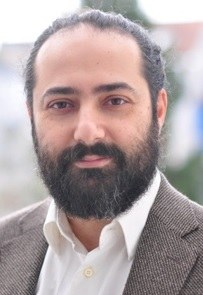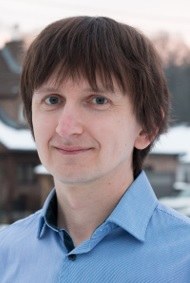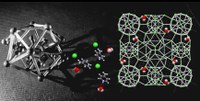The self-assembly of a simple organic molecule produces crystalline phases of extraordinary complexity: a publication in the prestigious journal Nature!
An international team of researchers lead by Dr. Riccardo Montis (University of Manchester) and including Dr. Luca Fusaro and Dr. Nikolay Tumanov (UNamur), has isolated a family of extremely complex crystalline structures obtained from a simple chloride salt of the fampridine[1] compound.
Molecular self-assembly, the spontaneous association of single molecules into larger ordered structures, represents a key step in several natural processes, such as the formation of crystals, proteins, viruses or double-helical DNA. Crystals are solid materials composed of atoms, ions or molecules arranged to form an ordered and highly symmetric three-dimensional pattern (the crystal structure).
In our everyday life we often deal with crystals. Sugar, salt, snowflakes, represent only few examples of these. Aspirin, paracetamol and several pharmaceutical compounds are produced as crystalline powders and compressed to form tablets. A given molecule can crystallize to form different crystal structures, resulting in different polymorphs, or include in the crystal lattice solvents and other molecules to form solvates, hydrates or cocrystals. Depending how the components are assembled in the solid-state, the resulting material will have different physicochemical properties, such as solubility, melting temperatures, mechanical properties, etc. For these reasons, the comprehension of how crystals are formed, how molecules are assembled in the solid-state, and how to control the resulting physicochemical properties is important.
In their article, the team of scientists reported the discovery of four new crystalline phases of fampridine hydrochloride. Two of these show an unusual complexity and represent the first observation of Frank-Kasper phases for a small organic molecule. Frank-Kasper phases have been previously observed for metal alloys, soft-matter and gold nanocrystal superlattices.
Starting from this observation, the researchers investigated the crystallization conditions of these phases, discovering that they might arise from an unusual molecular self-assembly in the liquid state, consisting of spherical aggregates of molecules. This discovery might contribute to the comprehension of the mechanisms of nucleation of organic crystals and opens perspectives for the design of new classes of materials with tunable physicochemical properties.
In the international team collaborating in this study, the complementary expertise of the two researchers, Luca Fusaro and Nikolay Tumanov, and the advanced technical resources of the PC² platform were required to monitor the self-assembly in liquid state and characterize some of the properties of the resulting crystal structures, helping to solve this puzzle.
Applications and perspectives
This study represents a reality check for the crystal engineering community, aimed to investigate and design crystalline material with specific properties. The fact that a simple organic molecule can self-assemble to form crystal structure of extraordinary complexity confirms that the comprehension of this phenomenon is still far from being achieved. However, the observation of spherical aggregates of molecules in the liquid state opens new perspectives for the design of new classes of functional materials. The authors suggest that these spherical objects might be used as supramolecular building blocks and combined with other species to generate new liquids or crystalline materials with specific properties. Although there are still several questions to be answered, this discovery will undoubtedly enable researchers, both in basic and applied research, to explore unprecedented avenues in the design of new materials.
The PC² platform expertise and equipment
The PC² platform has a wide expertise in the characterization of the physicochemical properties of materials by, among others, nuclear magnetic resonance (NMR) and X-ray diffraction.

 Luca Fusaro received his degree in Chemistry at Università di Cagliari (Italy) in 2004. In 2009 he received his PhD, obtained in collaboration between the Università di Cagliari and Université Libre de Bruxelles (Brussels, Belgium), studying several supramolecular systems in solution by NMR. From 2009 to 2014 he worked at ULB, under the supervision of Prof. Michel Luhmer, developing the use of heteronuclear NMR in solution. Since 2014 he was appointed as Research Logistician, manager of the NMR facility, and technical director of PC2 technological platform at University of Namur. His research interests cover different aspects of supramolecular chemistry and catalysis, with specific focus on the use of liquid and solid-state NMR spectroscopy. The NMR facility hosted at UNamur comprises four high-field NMR spectrometers for liquid and solid-state samples, with magnetic fields comprised between 9.4 and 14.1 T (400-600 MHz).
Luca Fusaro received his degree in Chemistry at Università di Cagliari (Italy) in 2004. In 2009 he received his PhD, obtained in collaboration between the Università di Cagliari and Université Libre de Bruxelles (Brussels, Belgium), studying several supramolecular systems in solution by NMR. From 2009 to 2014 he worked at ULB, under the supervision of Prof. Michel Luhmer, developing the use of heteronuclear NMR in solution. Since 2014 he was appointed as Research Logistician, manager of the NMR facility, and technical director of PC2 technological platform at University of Namur. His research interests cover different aspects of supramolecular chemistry and catalysis, with specific focus on the use of liquid and solid-state NMR spectroscopy. The NMR facility hosted at UNamur comprises four high-field NMR spectrometers for liquid and solid-state samples, with magnetic fields comprised between 9.4 and 14.1 T (400-600 MHz).
Nikolay Tumanov graduated from Novosibirsk State University (Russia) in 2008 with a master degree in solid-state physics. He obtained a PhD degree (solid-state chemistry) from the same university in 2011, under supervision of Prof. Elena V. Boldyreva. His PhD work was focused to experimental studies of amino acids at high pressure by diffraction methods. He continued his career as a post-doctoral researcher at UCLouvain (Louvain-la-Neuve, Belgium) studying hydrogen-rich materials. In 2016, he was hired by the chemistry department of the University of Namur as a Research Logistician. Since 2016, he is working at the PC2 technological platform of the University of Namur as a specialist in X-ray diffraction and thermal analysis. X-ray diffraction facility of UNamur comprise one single-crystal X-ray diffractometer and two powder X-ray diffractometers (high-resolution and routine).
This research is possible thanks to the high-level equipment hosted by the PC2 technological platform funded by UNamur and the FNRS.
The international team
- University of Southampton- School of Chemistry, Southampton, UK - Riccardo Montis, corresponding author (current address: The university of Manchester - Department of Chemical Engineering and Analytical Science, UK), Michael Hurthouse, Terry Threlfall
Simon Coles & Peter Horton (National Crystallography service - University of Southampton)
- Kaust King Abdullah University of Science and Technology (KAUST), Thuwal, Saudi Arabia Andrea Falqui (NABLA Lab, Biological and Environmental Sciences and Engineering (BESE) Division, current address: Università di Milano, Dipartmento di Fisica, Italy) - Rachid Sougrat (Core Labs)
- Université de Rouen Normandie, Laboratoire SMS—EA3233, Mont Saint Aignan, France -Gérard Coquerel & Anaïs Lafontaine
- Research school of Chemistry, College of Physical Science, Australian national University, Canberra, Australia - David Rae
- University of Namur, Department of Chemistry, NISM institute, PC² platform, Belgium - Luca Fusaro & Nikolay Tumanov
Article online: https://doi.org/10.1038/s41586-021-03194-y
Contact: Luca Fusaro - More information: https://platforms.unamur.be/pc2/index
[1] Fampridine is a drug that has been shown to improve walking speed for some adults with multiple sclerosis.


